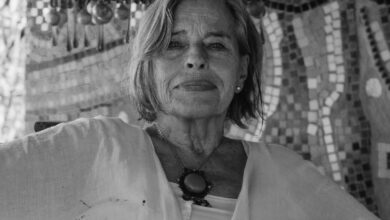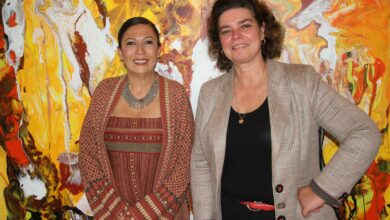Egyptian painter Hany Rashed has undergone many stylistic shifts throughout his career, displaying a kind of risk-taking curiosity that has the potential to reveal exciting new work. Or to disappoint.
The latter, unfortunately, is the case with his eighth solo exhibition entitled Beware of the Chili, which opened last week at Cairo's downtown Mashrabeya Gallery. The large paintings that cover the ample space do not seem to belong to a coherent ensemble, and any theme or message fails to truly capture the viewer. But if classification has to be done, the works could be separated into distinct groups.
On the one hand, there is the artist’s interest in symmetrical paintings, ones that give the impression that the painting has been folded in two so that one side imprints itself on the other side, similar to an ink blot. In this vein, Rashed presents a large, blossoming artichoke flower, flanked by two soldiers. He also represents twice a cowboy dressed in an outfit so traditional it seems like a caricature–a leather jacket and colored scarf knotted around his neck.
Each painting in the second group revolves around one single topic with seemingly-pointless naivete. A painting entitled “Samak” (fish), for instance, represents a large variety of marine creatures–from the octopus to the shark to the figure of a fully-equipped diver, all painted on a predictable blue background. Hung close to it, another painting shows a bestiary of zoo animals, the highlight being a framed monkey whose various body part names are specified with arrows, on a sad salmon pink.
A painting called “Sports,” which has a lot in common with a Soviet state healthy lifestyle advertisement, is part of a group of paintings resembling non-core illustrated books for children between the ages of two and three.
The rest of Rashed’s work might be categorized under a “pop culture advertisement” section. These paintings display typical Western imagery with a Middle Eastern twist, conveyed via scattered Arabic words. The painting that gave its name to the exhibition, “Beware of the Chili,” shows a character erupting out of the frame, represented twice with the ink blot technique the artist seems to cherish. Three main colors–red, blue and yellow–give this painting a sense of efficiency similar to American billboards prominent during the glorious economic growth that followed World War II.
“Beware of the Chili,” and other paintings, resemble propaganda posters glued on the walls of the wrong country, and display a lack of vision on Rashed’s part. Another painting–of two women gossiping about a third one, their wavy hair done in the 50s style with glossy lips–is reminiscent of the glamorous dark-haired pin-ups of the United States circa the 40s and 50s. The female Arabic names written in Arabic in the painting’s margins aim to connect it to a local context, but in a rather shallow way.
In another work, Rashed paints everyday objects (a teapot, an iron, a bra, a bucket) on green grass, leaving very little space between each item. Is the work a criticism of Western consumerism that fills life with objects, no matter how useful they turn out to be?
The curious viewer may never know. When questioned about these works, Rashed asserted the idea behind the painting matters less than the image itself.
“I compose posters where I try to arrange lines, shapes and colors together, without necessarily conveying a message,” he said, pointing at the bestiary, the fish and the sports paintings. A former sound manager for the Egyptian television, Rashed admitted that a certain type of televised imagery has invaded his artwork, comparing his paintings to a “montage” of images.
Rashed’s earlier collage work, depicting random people with blank faces, had much more significance than the work on display here. Beware of the Chili resembles the aesthetic of television: rapidly digested and forgotten.
Beware of the Chili is on display at the Mashrabeya gallery through 14 January.




